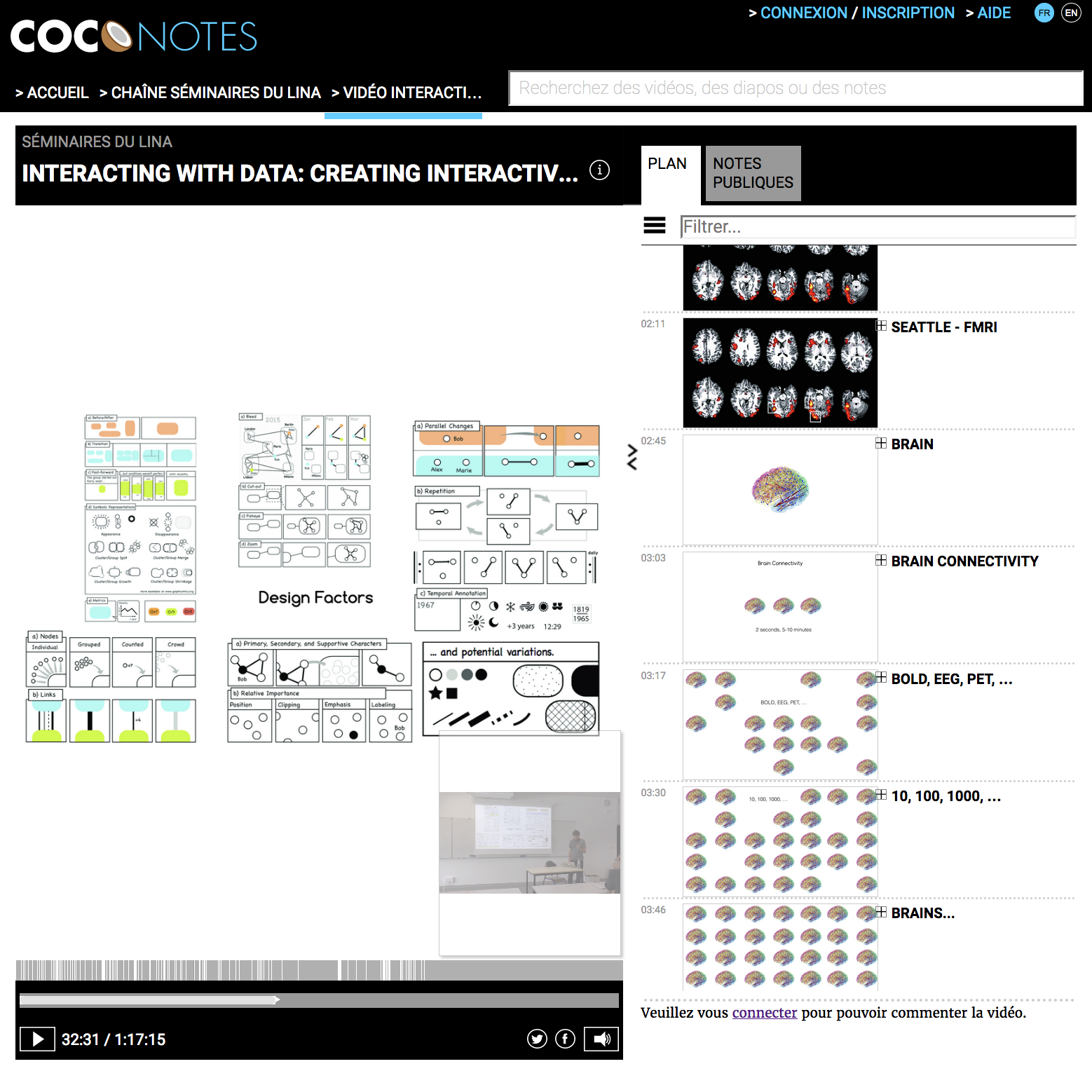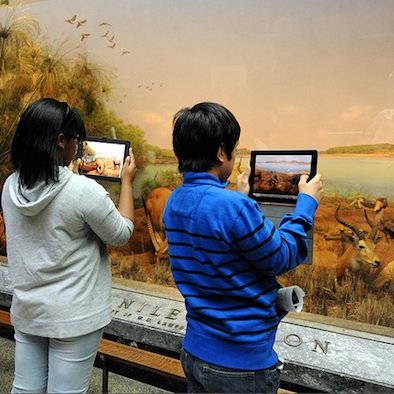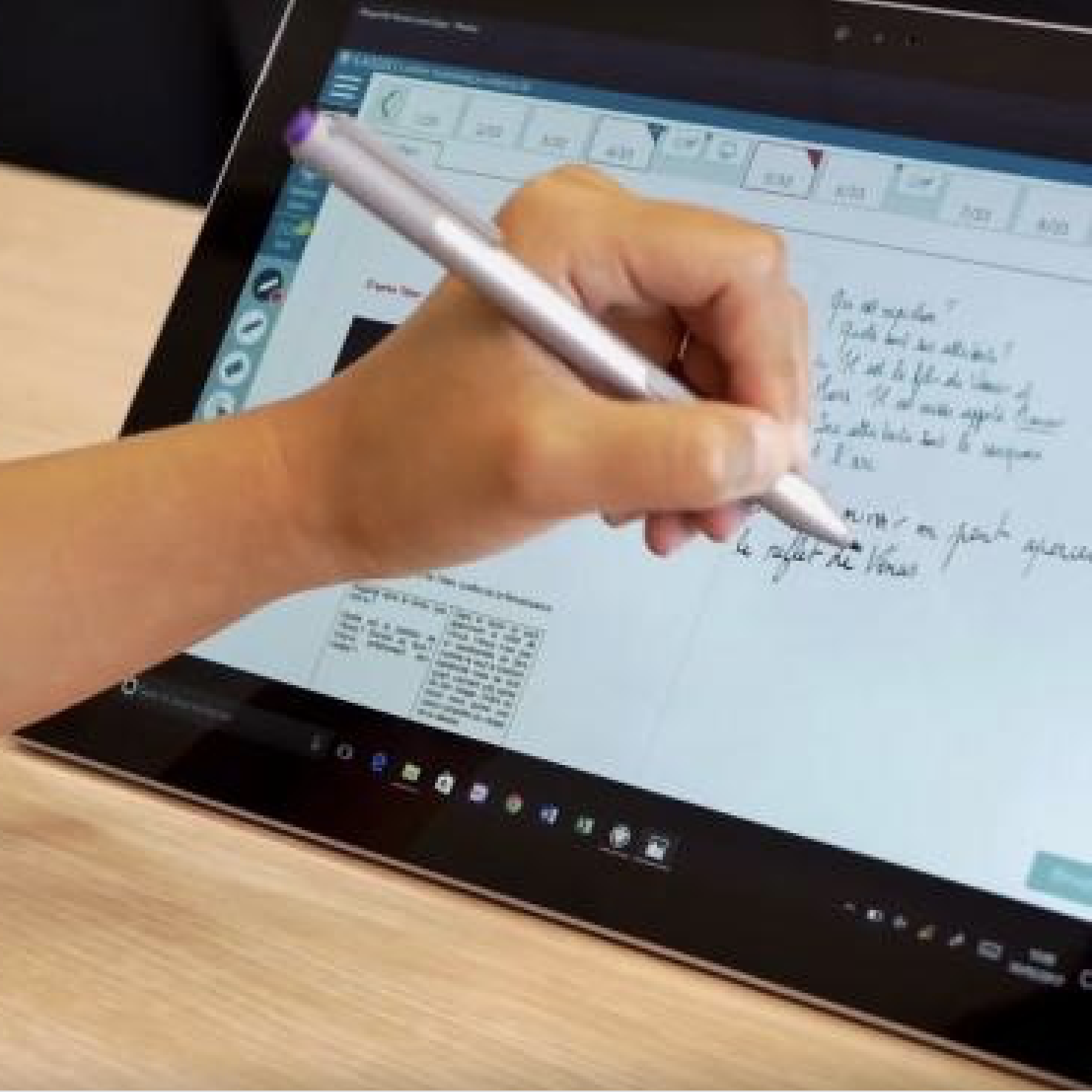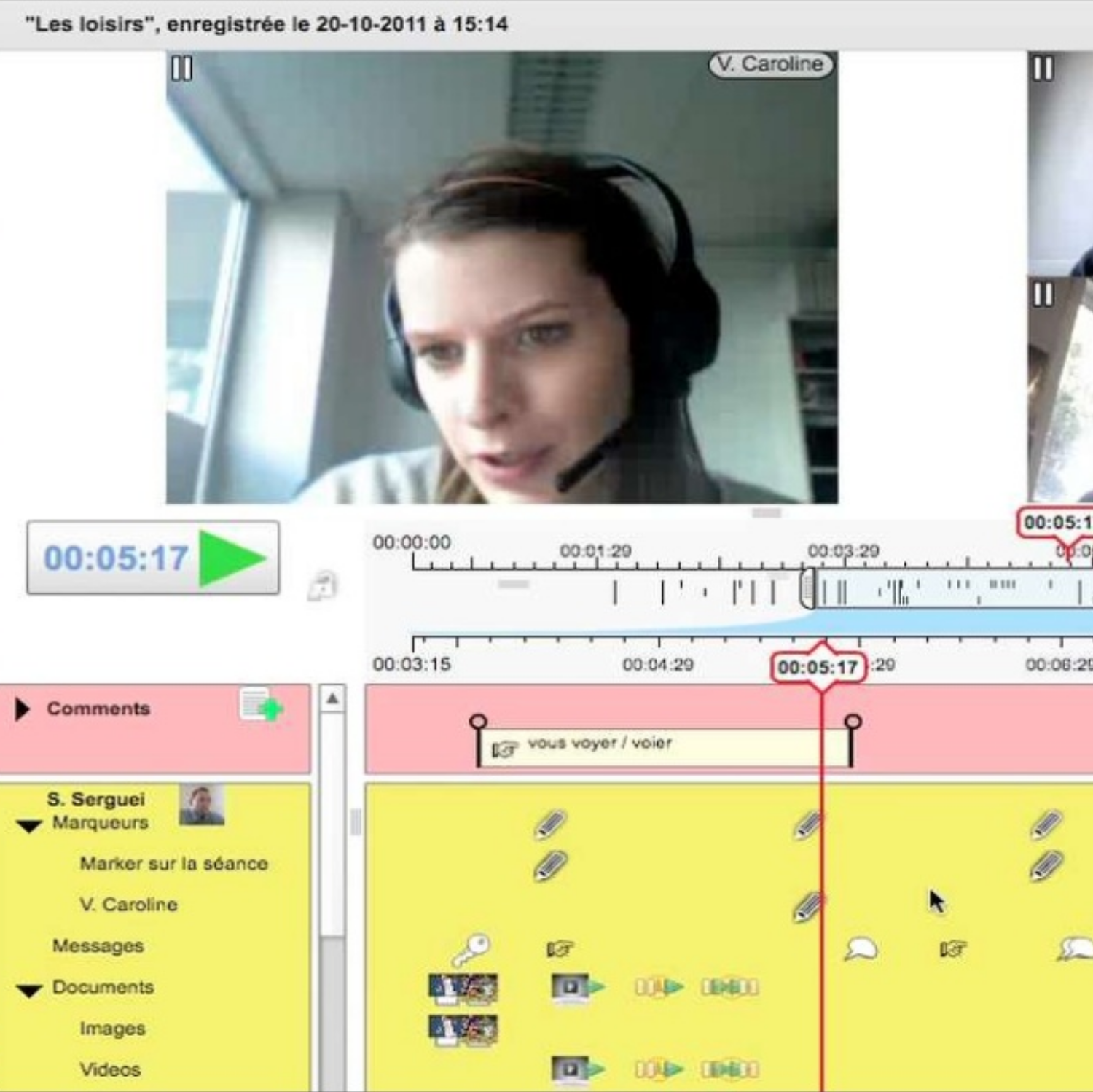Some project give the occasion to design and build innovative systems for teaching and learning.
-

COCo: Comin Open Courseware
Technology-Enhanced Learning
Hypervideos
Video Annotations
Research and development aimed at leveraging annotations in video-centered pedagogical resources, creating open courseware multimodal content for knowledge diffusion, and exploring new techniques for e-learning. More than 30 courses and seminar videos have been produced.
Details
Partners: LS2N
Funding: Labex Cominlabs
Cofunding: Région Pays de la Loire
Beginning: 2013-09-01
End: 2016-12-31
Website: http://www.comin-ocw.org/
Related publications
-
Camila Canellas, Olivier Aubert, Yannick Prié. (2015) Prise de note collaborative en vue d’une tâche : une étude exploratoire avec COCoNotes Live in 17ème Conférence sur les Environnements Informatiques pour l'Apprentissage Humain (EIAH 2015), Jun 2015, Agadir, Maroc. pp.204-209, 2015 Show abstract Les enregistrements de présentations orales telles que celles effectuées lors de conférences peuvent souvent constituer une base pour 1) une nouvelle activité basée sur leur contenu, 2) une autre forme pour le même contenu, ou 3) une combinaison avec d'autres documents. Cependant, les enregistrements vidéo peuvent se révéler difficiles à naviguer et explorer. Nous présentons ici les résultats préliminaires d’une situation où un outil de microblogging est utilisé durant l'enregistrement pour produire des annotations catégorisées et synchronisées avec l'enregistrement. Les annotations sont ensuite utilisées pour naviguer dans l'enregistrement et produire de nouveaux documents, dans le contexte d'une tâche spécifique.
-
Olivier Aubert, Yannick Prié, Camila Canellas. (2014) Leveraging video annotations in video-based e-learning in 6th International Conference on Computer Supported Education, Barcelona, Spain, April 2014 Show abstract The e-learning community has been producing and using video content for a long time, and in the last years, the advent of MOOCs greatly relied on video recordings of teacher courses. Video annotations are information pieces that can be anchored in the temporality of the video so as to sustain various processes ranging from active reading to rich media editing. In this position paper we study how video annotations can be used in an e-learning context - especially MOOCs - from the triple point of view of pedagogical processes, current technical platforms functionalities, and current challenges. Our analysis is that there is still plenty of room for leveraging video annotations in MOOCs beyond simple active reading, namely live annotation, performance annotation and annotation for assignment; and that new developments are needed to accompany this evolution.
Related software
Additional comments
The project was focused on open education and open course ware (OCW), all material is available on the project website.
-

ECBridge: Education-Curation Bridge
Data Visualization
Learning Analytics
Technology-Enhanced Learning
EC Bridge aims to create software linking platforms dedicated to the world of education and cultural mediation, to offer cultural institutions support for new educational experiences linking schools, museums, and families. In this project we are implicated in the scenarios in the design of trace-based dashboard for learners, curators, and students.
Details
Partners: Mazedia, Maskott, LS2N, Ifé ENS-Lyon, Cité des Télécoms, Musée gallo-romain de Fourvière
Funding: FUI 23
Beginning: 2017-09-01
End: 2019-12-31
-

eFIL: e-Feedback for interactive Lecture
Data Visualization
Learning Analytics
Reflective Systems
Technology-Enhanced Learning
The project aims at experimenting in lab / classroom the usage of a handwritten note-taking tablet application, that also allows the creation of pedagogical activities (quiz, whiteboards). We want to study the impact of technology instrumentation on active learning methods, and the usage of activity traces for analysis and production of synchronous and post-hoc activity visualisation dashboards, mainly targeted at teachers.
Details
Partners: LS2N, IntuiDoc, LP3C
Funding: Cominlabs Labex
Beginning: 2017-10-01
End: 2019-12-31
Website: https://efil.cominlabs.u-bretagneloire.fr/fr
-

ITHACA: Interative Trace for Human Awareness in Collaborative Annotation
Reflective Systems
Technology-Enhanced Learning
Trace-based Systems
Video Annotations
In this project carried with education scientists, we explored the use of traces in synchronous videoconference-based communication, mainly in the context of language teaching. We built two versions of the Visu tool, that was used in multiple settings..
Details
Partners: LIRIS, Lyon 2 University, ICAR Laoratory, TECFA Geneva
Funding: French National Research Agency (ANR)
Beginning: 2008-10-01
End: 2011-12-31
Website: https://projet.liris.cnrs.fr/ithaca/
Related publications
-
Elise Lavoué, Gaëlle Molinari, Yannick Prié, Safè Khezami. (2015) Reflection-in-Action Markers for Reflection-on-Action in Computer-Supported Collaborative Learning Settings in Computers & Education, Volume 88, October 2015, Pages 129–142. doi Show abstract We describe an exploratory study on the use of markers set during a synchronous collaborative interaction (reflection-in-action) for later construction of reflection reports upon the collaboration that occurred (reflection-on-action). During two sessions, pairs of students used the Visu videoconferencing tool for synchronous interaction and marker setting (positive, negative or free) and then individual report building on the interaction (using markers or not). A quantitative descriptive analysis was conducted on the markers put in action, on their use to reflect on action and on the reflection categories of the sentences in these reports. Results show that the students (1) used the markers equally as a note-taking and reflection means during the interaction, (2) used mainly positive markers both to reflect in and on action; (3) paid more attention in identifying what worked in their interaction (conservative direction) rather than in planning on how to improve their group work (progressive direction); (4) used mainly their own markers to reflect on action, with an increase in the use of their partners' markers in the second reflection reports; (5) reflected mainly on their partner in the first reflection reports and more on themselves in the second reports to justify themselves and to express their satisfaction.
-
Elise Lavoué, Gaëlle Molinari, Safè Khezamy, Yannick Prié. (2013) How do Students Use Socio-Emotional Markers for Self-Reflection on their Group Work in CSCL Settings? A Study with Visu: a Synchronous and Delayed Reflection Tool in 10th International Conference on Computer Supported Collaborative Learning, Madison, USA, 2013 [AR:39%] Show abstract This paper describes an exploratory study on the use of reflective markers set during synchronous collaborative learning sessions (reflection in action) for later construction of self-reflection reports upon the collaboration that occurred (reflection on action). During 2 sessions, students used the Visu tool for interaction and marker setting (positive, negative, free) and then report building on the interaction (using markers or not). A quantitative descriptive analysis has been conducted on the markers used and on the reflective categories of the sentences in the reports. Results show that students (1) paid more attention in repairing their relationship than reflecting on learning and task goals; (2) used mainly positive markers to both reflect in and on action; (3) used more their partner's markers in the second reports; (4) reflected more on themselves in the second reports to justify successes and failures, and to express satisfaction.
-
Elise Lavoué, Safè Khezami, Gaëlle Molinari, Yannick Prié. (2013) The Visu Reflection Tool for Socio-Emotional Awareness in CSCL situations in Workshop on Tools and Technologies for Emotion Awareness in Computer-Mediated Collaboration and Learning. Alpine Rendez-Vous (ARV) 2013, Villars-de-Lans, Jan 2013. Show abstract An exploratory study has been conducted in which 12 students in Bachelor of Science in Psychology were asked to use the Visu reflection tool during Computer-Supported Collaborative Learning (CSCL) situations. Visu is a web videoconferencing platform that allows participants to put reflective markers during their collaborative learning activity, and to review the traces of their synchronous collaboration later. In this study, co-learners used two types of markers: (1) free markers and (2) socio-emotional markers to express either negative or positive feelings about the way they collaborate together. Our contribution is related to the first focus of the workshop: emotion awareness in CSCL. In line with this focus, our main questions are as follows: (1) How can the Visu tool help learners express and share their feelings about collaboration? How does this affect the way they interact and learn together? (2) How do they use the Visu markers after the collaboration to self-reflect on their group processes? In this paper, we first describe the Visu platform. We then present a study we have carried out to answer the questions presented above. We finally conclude with the contributions of our research to the workshop topic.
-
Nicolas Guichon, Mireille Bétrancourt, Yannick Prié. (2012) Managing written and oral negative feedback in a synchronous online teaching situation in Computer-Assisted Language Learning, 25(2):181-197, 2012. doi Show abstract This case study focuses on the feedback that is provided by tutors to learners in the course of synchronous online teaching. More specifically, we study how trainee tutors used the affordances of Visu, an experimental web videoconferencing system, to provide negative feedback. Visu features classical functionalities such as video and chat, and it also offers a unique marking tool that allows tutors to take time-coded notes during the online interactions for later pedagogical remediation. Our study shows that tutors mainly use verbal and chat feedback, with significant inter-individual variability, and that tutors who provide verbal feedback are more likely to use markers. Marking takes time because of the dual task that it entails for the tutor. Idiosyncratic strategies in the use of markers are evidenced. These results clearly show the value of markers for negative feedback, signal the need for their explicitness, and also call for an evolution of the Visu interface so that tutors can better negotiate the task of online tutoring and the pedagogical stance they have to take on in their interactions with the learners.
-
Mireille Bétrancourt, Nicolas Guichon, Yannick Prié. (2011) Assessing the use of a Trace-Based Synchronous Tool for distant language tutoring in 9th International Conference on Computer Supported Collaborative Learning. Hong Kong. pp 486-493. Jul 2011. [AR:36%] Show abstract This article presents a pilot study carried out to investigate the potential of a functionality marker setting, included in a synchronous collaborative videoconferencing platform (VISU). Markers, supported by a trace-based system, are designed to facilitate tutors' activity. They provide tutors with (1) the possibility of annotating their distant learners' learning activity, and (2) information pertaining to their own behavior during pedagogical interaction, which can potentially enhance their professional performance as online language tutors. This study concentrates on the marker-based traces of eight language tutors collected in the course of pedagogical interactions with their distant learners during a seven-week transnational collaborative project. It presents both quantitative and qualitative analyses of the use of markers during synchronous language teaching sessions and assesses the utility and usability of such a functionality for language tutoring in order to inform future design and training.
Related software
Select another theme:
Accessibility
Affordances
Data Visualization
Digital Instruments
Document Engineering
Experience analysis and modelling
Hypervideos
Immersive Analytics
Interpretation Systems
Knowledge Engineering
Learning Analytics
Patient Experience
Progressive analytics
Reflective Systems
Technology-Enhanced Learning
Trace-based Activity Analysis
Trace-based Systems
VR and Psychotherapy
Video Annotations
Virtual Reality




